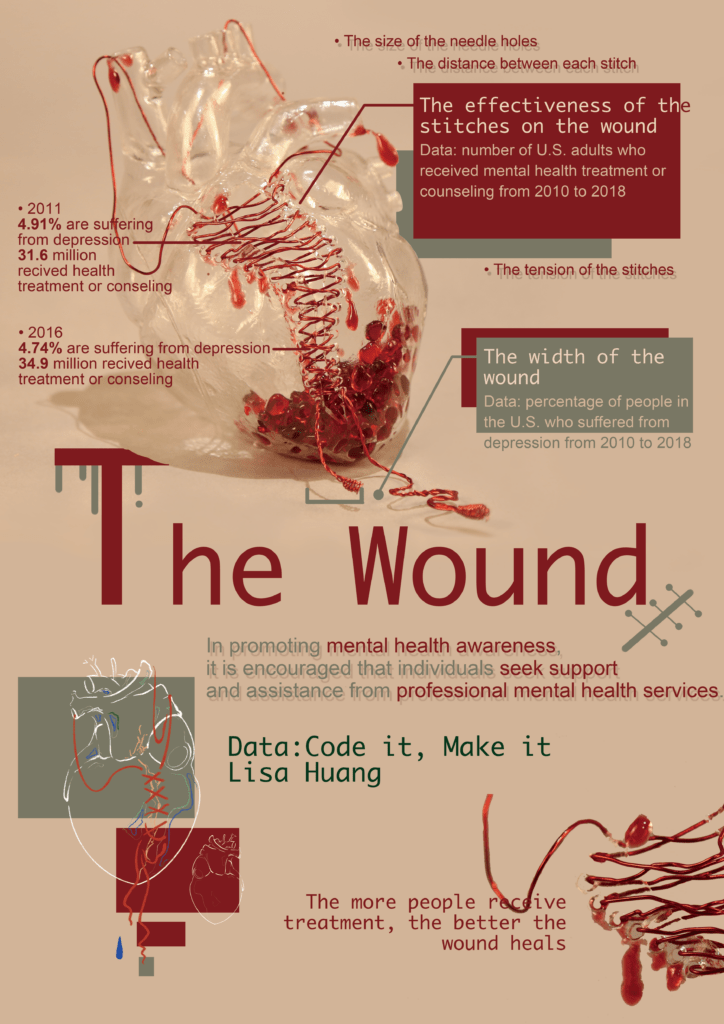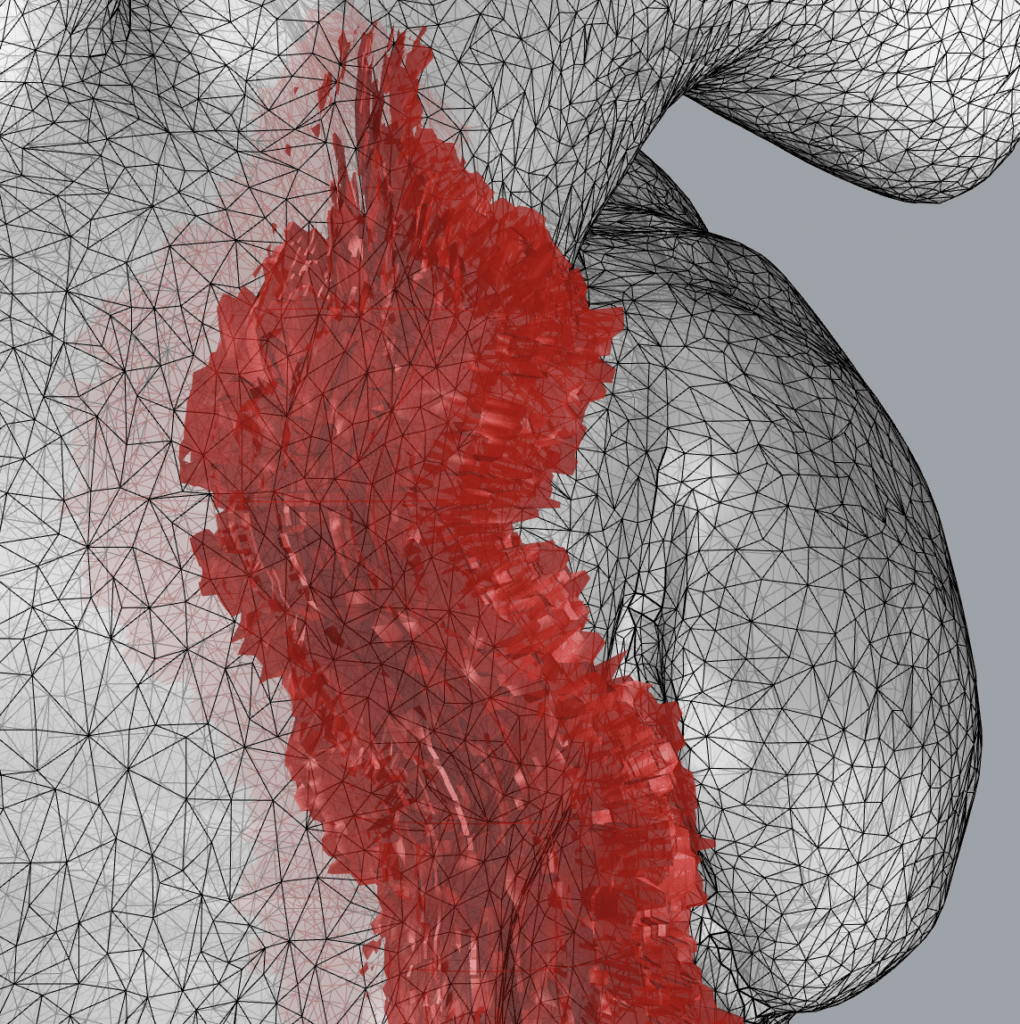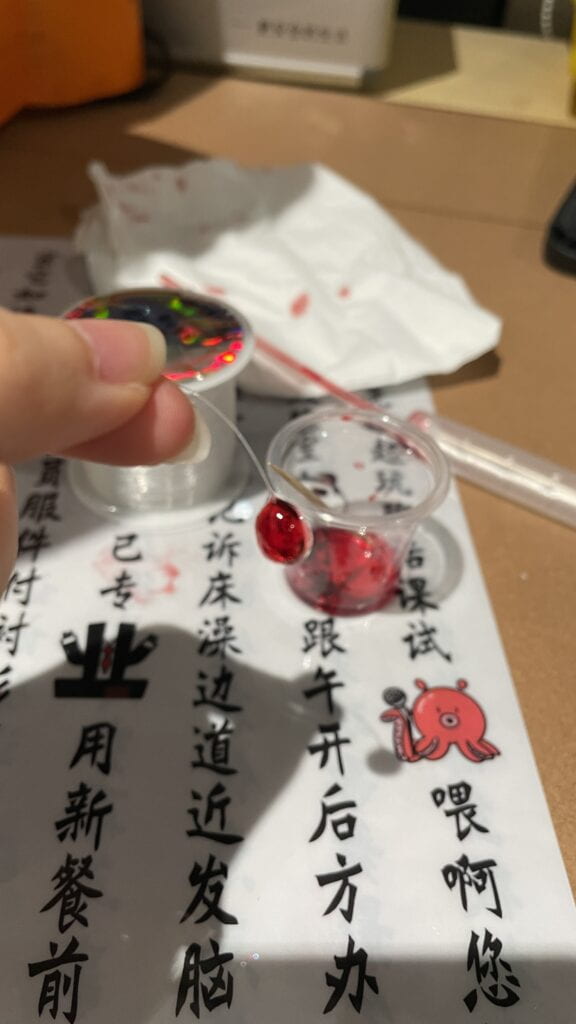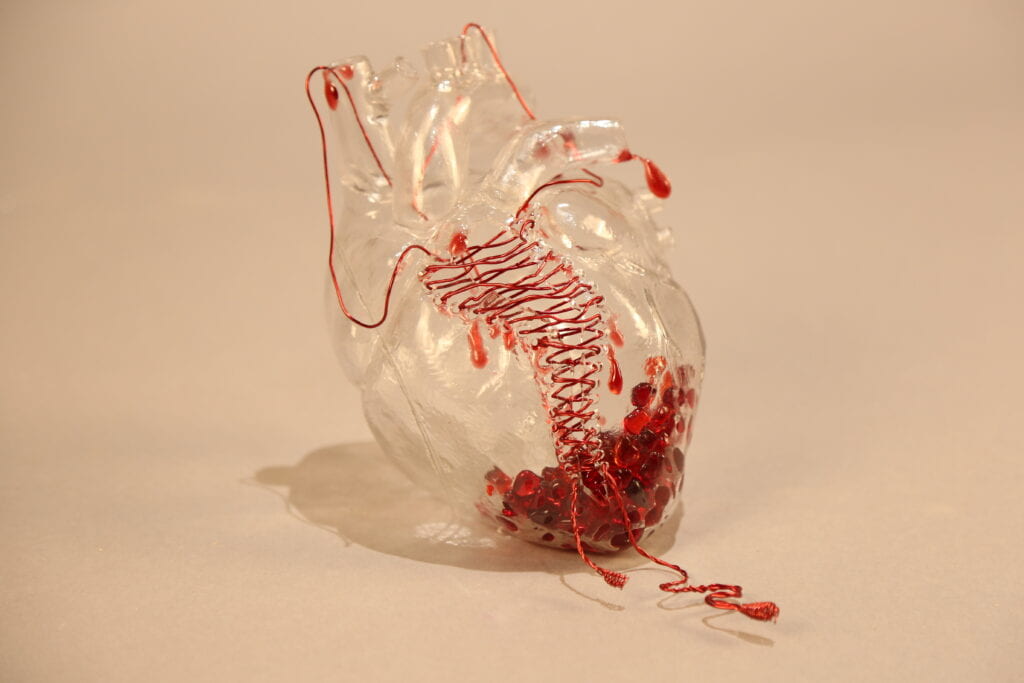
In promoting mental health awareness, it is encouraged that individuals seek support and assistance from professional mental health services.
This is my final project. As we can see from the poster, the width of the wound represents the percentage of people in the US who suffered from depression from 2010 to 2018. It is presented in sequential order from top to bottom, representing data from 2010 to 2018. The effectiveness of stitches on the wound represents the number of US adults who received mental health treatment or counseling from 2010 to 2018. The elements to show the effectiveness include the size of the needle holes (the smaller, the better; the more people undergoing psychological treatment, the greater the effectiveness), the distance between each stitch (the closer, the better), and the tension of the stitches (the tighter, the better).
Inspiration:
This final project draws primarily from a personal experience during this semester when I sought psychological therapy due to anxiety related to academic and life challenges. Confronting academic and life-related anxieties, I initiated the process of seeking help from a professional psychological counselor. It is from this experience that my project takes life.
The elements of sewing are derived from the final project “Resonance” of students in the material course at CAFA (Central Academy of Fine Arts). “Resonance” narrates the pain and turmoil of the disabled author mentioned in the book.

At first glance, the intriguing combination of sewing thread and paper deeply captivated me, and the concept of ‘mending’ instantly surged within. Fusing this idea with the theme I wished to convey, I decided to narrate the positive significance of undergoing psychological therapy through the artistry of a heart intricately sewn together. As I delved into understanding the field of psychological counseling, I observed a prevailing bias against psychological therapy among a substantial portion of the population. Some individuals dismiss the significance of psychological issues, perceiving therapy as an acknowledgment of mental problems. Others resist opening up to mental health professionals, choosing instead to keep their emotions and struggles concealed. Aiming to encourage more people to receive such kind of treatment, I bring out this idea.
In “Wound”, several key elements hold particular significance:
- Take form as a heart: The external representation of the heart is a symbolic embodiment that comes to mind when individuals experience psychological trauma. By using the heart as a model, it allows the audience to better relate to psychological issues. Following the concept of “The Medium is the Message”, the 3D-printed heart serves as the medium itself, inherently conveying a significant portion of information.
- Mending thread: The term ‘mending thread’ refers to the psychological therapy individuals undergo, representing an ongoing healing process (缝 -治疗). Additionally, the mending thread extends from the heart’s vessels, symbolizing that the process of healing psychological illnesses is, in essence, a self-healing journey. Because, apart from yourself, no one can forcibly make you seek psychological counseling or treatment. The decision to accept and open up is a personal process where you are helping yourself and facilitating your own recovery.
- Choice of stitching style: Resembling a bit like tying shoelaces, I deliberately avoided opting for a realistic portrayal of how wounds are stitched in medicine. The emphasis lies more on the ‘process of stitching.’ However, upon reflection, I can consider experimenting with a surgical stitching approach to make the stitch more vivid.
- Wound: The wound represents the actual psychological illnesses people endure, the trauma it causes, and the urgent need for professional psychological therapy to mend.
After conceiving this idea, I felt exceptionally excited. On one hand, it is closely tied to my real-life experiences, and the creative process is sure to provide me with deeper contemplation and reflection on this behavior. On the other hand, I sense a responsibility on my shoulders. Similar experiences or issues connect me with others, and for the first time on this journey, a project can draw nourishment from the soil of “myself.” It reaches out to others, allowing the blossoming of beautiful flowers in the hearts of numerous people I have yet to meet. Since the inception of this idea, a connection has been forged between “me” and “others.” Today, as I cradle this 3D-printed heart, I can almost feel the heartbeat of others.
At the proposal stage…
After proposing the idea, some of my questions were also answered. I bought heart model on Taobao. (picture) and The distance of the pinholes is controlled by the radius of the circle.
The process of searching for data…
After the proposal, I was suggested to find two datasets. One is about people receiving the mental treatment, one is people having such kind of mental issue. However, at first, I wa not able to find what I want exactly. The datasets are more about substance abuse or data in just one or two years. To solve this problem, I realized that different datasets may serve various functions, focusing on different domains. My approach shifted from finding specific data to first identifying websites that offer datasets in the psychological domain.
That’s how I find statista, a website has a specific column for mental health. And luckily, as NYU students, I get access to the majority of them. Here is what I found:


Modeling process:
process my data

wound
Starting the process of creating the wound, I began by shaping its form. The plan is to initially craft the outline of the wound and then use ‘Mesh Boolean Difference’ to cut out the wound’s size on the heart. After exploring all the photos on YouTube related to creating textures, I decided to utilize displacement within Rhino for this purpose.






A small problem: the texture created by displacement only shows in the rendered mode in Rhino

Solution: To print it, I exported the wound model in STL format, and fortunately, the texture remained intact after the export! So I then re-import the stl file into Rhino, and difference them with the heart.
But the modeling of the pinholes was not as smooth and straightforward.

I initially intended to draw inspiration from our previous instructional videos, using Kangaroo to create a series of cylinders aligned parallel to surfaces of the heart, and then subtract them collectively. In order to align the inclination of the cylinders with the undulations of the heart’s surface (see sketch), I plan to use ‘Surface Closest Point’ to obtain UV points . However, I can’t locate the surface of the mesh.

My computer crashed when I attempted to extract surfaces from the mesh using the following method – it simply stopped working.
To address this issue, I manually created a surface in Rhino with a curvature similar to the desired one. However, I noticed that these circles weren’t closely packed; there were gaps in between. These gaps made the differences in radius sizes lose their significance. And sometimes, the circle will move out of my line.
So I seek help from Marcele.




Here I’ll explain a little bit why the previous method I use failed:
I think that is because the one I am using doesn’t consider the curve’s real length compared to the circles’ radius. My code didn’t take into account the proportions between each radius and how to distribute the entire line proportionally among these 11 circles. Marcele’s code consider the proportions so that the circle won’t move out of the curve if the sum of the diameters of the 11 circles exceeds the distance of the entire curve, and there is no gap between them if the sum is less than the distance of the curve. It is completely assign the space to 11 cute circles.
After I creating the spheres, I bake them in the Rhino, squeeze them and adjust the direction manually.
After print the prototype and first presentation…

The problems I have and the changes I’ve made:
-

The incision divided the model into upper and lower halves, affecting the audience’s interpretation of the stitched wound area. — The incision has been positioned to the far left, ensuring it doesn’t interfere with the wound and stitching.
- The data shown in the wound is not obvious, small difference between each year — make the size of the wound larger. Reprocessing the data, I chose to trim a baseline to magnify the differences in their sizes

- The data representing individuals undergoing psychological therapy is not extensive enough, and the time span is not long, insufficient to depict the changing trends in this dataset. — integrate more data from a larger year span. Use one cross to represent one year to make the data clear.

- I was asked to Exclude the use of wires — I switched to using finer iron wires

- The hole could have variation— I change the radius of each hole. The size of the openings is inversely proportional to the number of individuals receiving treatment each year.

On Tuesday afternoon, after receiving the 3D-printed model, I began manually decorating my transparent heart. I aim to emphasize the urgency of healing psychological illnesses by depicting flowing blood at the wound, creating an emotional connection and communication with the audience. This marks my second attempt at crafting something using resin.


After the second presentation two days before IMA show:

Rejected idea: Embedding small red stones in the transparent heart.
I want to emphasize the urgency of mending the wound, essentially encouraging those with relevant needs to actively seek psychological therapy. To highlight this urgency, if something is flowing out from the inside, wouldn’t we have to stitch it up to prevent it from flowing out? Therefore, I thought of using small stones to represent our energy. To maintain mental health, we need to retain our energy.
Reason for rejection: The idea resembled a pomegranate, but pomegranates themselves are unrelated to my topic. Due to transparency, the stones placed inside affected our perception of the stitching thread, hindering the presentation of integrated data.
Adding a needle: Emphasizing the concept of “sewing”.


Future development:
The represented data: The data I used for the wound represents the number of people suffering from depression in the United States each year. However, depression is just one of the more common mental issues. To better reflect the population undergoing psychological therapy, it would be ideal to incorporate data representing a broader spectrum of mental health issues (currently in the process of searching).
The limitations of the data: During the exhibition, someone asked me why I didn’t choose data from China. I hesitated for a moment and replied that while Chinese data could indeed connect with my personal experiences, I didn’t find relevant datasets online.
The material of the thread: Upon reflection after the IMA show, I realized that using real yarn for stitching could be a good approach. I appreciate the collision of different textures. In another class, I read, “The creation of something new is the placing of something old in a unexpected context.” I never thought about using needle and thread to mend gaps in resin. Furthermore, the process of healing oneself should be gentle and warm. Iron wires are too rigid, not quite in line with the concept of ‘treatment and cure.’ I like the idea of using soft threads to mend what seems to be “hard” wounds.
For this wonderful course journey:
In the end, let’s return to this class. I’m thrilled to have had the opportunity to be a part of this class, especially after our collective journey to Shenzhen, where I discovered that the relationships among classmates had grown closer. I cherish the little collective born out of our shared learning goals, where we supported each other in class, spoke freely during critiques, all with the common goal of improving each person’s project. Despite feeling a bit challenged at times, I’m grateful that in each project, I tried many new and different things. Regardless of the outcomes, I found immense satisfaction in the process of exploration.
A special thanks to Marcele for her hard work. Because of Marcele, I had an unexpectedly delightful trip to Shenzhen. With her guidance, I didn’t feel lost or overwhelmed when facing Rhino and Grasshopper without a clue. I enjoyed the field trip in Shenzhen, loved Marcele’s thoughtful breakfasts and coffees, cherished the relaxing presentations done on the school bus, and appreciated the precious and sincere advice during each critique.
Thank you, Professor, and thank you to my classmates. I’m delighted to have spent this unforgettable semester with all of you!

Giving the credit to:
dataset for number of people receive mental treatment https://www.statista.com/statistics/794027/mental-health-treatment-counseling-past-year-us-adults/
dataset for people suffering depression https://www.statista.com/statistics/979880/percentage-of-people-with-depression-us/
“Resonance” http://xhslink.com/8ZWLvx
Tutoring in YouTube https://www.youtube.com/watch?v=Zzdvq6YJHRw&t=1026s
The model I bought online https://m.tb.cn/h.5NYoYkC?tk=O45lWUoyTzh CZ0001